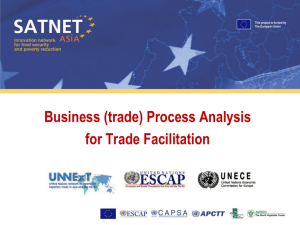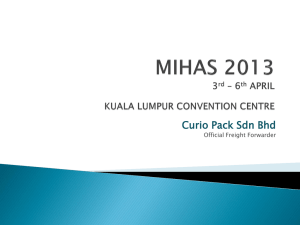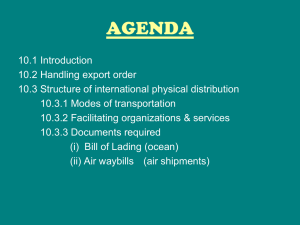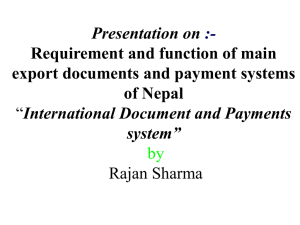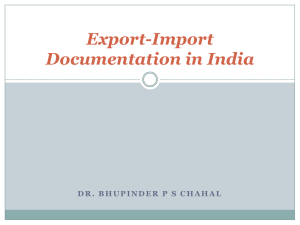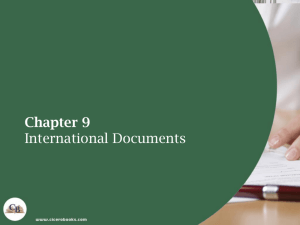Export Documentation KEI World Trade Center of KY
advertisement
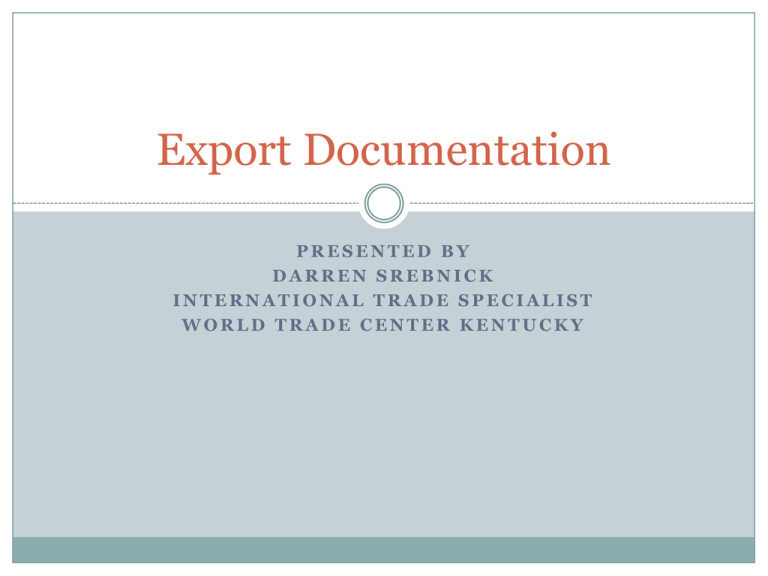
Export Documentation PRESENTED BY DARREN SREBNICK INTERNATIONAL TRADE SPECIALIST WORLD TRADE CENTER KENTUCKY Topics Documentation Commercial invoice Bill of lading Export Packing list Export and license declaration Certificate of origin Certificate of free sale Insurance certificate Letter of credit Other documentation Best practices and resources Commercial Invoice Key accounting document describing commercial transaction between buyer and seller Identifies the buyer and seller, describes the goods sold and all terms of sale (incoterms, payment terms, relevant bank information, shipping details) Often used by governments to determine the true value of goods when assessing customs duties Should be tied to purchase order Consular invoice may be required for certain countries Should include destination control statement should be part of invoice Bill of Lading Contract between the owner of the goods and the carrier Receipt for merchandise and contract to deliver Straight (non-negotiable) vs. shipper’s order (negotiable) Shipper's order bill of lading can be bought, sold, or traded while the goods are in transit. The customer usually needs an original as proof of ownership. Provides most details regarding the shipment and its transit from origin to destination Master vs. house bill of lading Export Packing List Detailed breakdown of items in shipment Individual net, legal, tare, and gross weights and measurements for each package are provided May include special marks for identification Used by consignee to check that shipment is complete Attached to outside of containers Quantity of items on invoice must match quantity on packing list Sometimes used by customs authorities to look for particular item in shipment Export and license declaration Formerly know as Shipper’s Export Declaration (SED) Electronic Export Information (EEI) - must be electronically filed via AES Direct Used by Census to collect trade data on the products, quantities, dollar value, volume and destinations of U.S. exports Internal Transaction Number (Sample: ITN X20091110000001) is applied to key shipping documents such as the Invoice, B/L Required for U.S. exports valued $2,500 or more per individual Schedule B Number (except Canada). Export license is issued for individual transactions determined by the product, country, end-use and the enduser. Certificate of Origin Issued by certifying authority attesting to country of origin of goods Certifying authorities are generally city and regional chambers of commerce Acts as key document to qualify for preferential treatment Some countries will accept generic certificate of origin, but others (e.g. Mexico) require specific form (NAFTA certificate of origin) Certificate of free sale Proves that goods offered for entry comply with domestic requirements for selling in US Very common requirement for agricultural, medicinal, or cosmetic products Depending upon purpose, may be issued by chamber, World Trade Center or government entity such as FDA Insurance Certificate Indicates the type and amount of insurance in force on a particular shipment for loss or damage while in transit Sometimes referred to as marine insurance, but may cover the entire voyage and other modes of transport Letter of Credit Risk mitigation tool Issued by a bank committing to pay the seller/exporter a stated amount of money on behalf of the buyer/importer as long as the specific terms and conditions are met. Must meet exact conditions outlined on the letter of credit Errors on the L/C are the most costly and time consuming for seller and buyer Other documents Shipper’s letter of instructions Declaration of dangerous goods Pre-shipment inspection ATA Carnet Dock Receipt and Warehouse Receipt Fisheries certificate Fumigation certificate Halal certificate ISPM 15 (Wood Packaging) Phytosanitary certificate Certificate of weight Best practices Verify documentary requirements through multiple sources Send documents in advance of shipment as a “trial run” Be careful of discrepancies between letter of credit and other export documentation Utilize knowledge of distributor for export documentation purposes Network with exporters who have extensive experience



